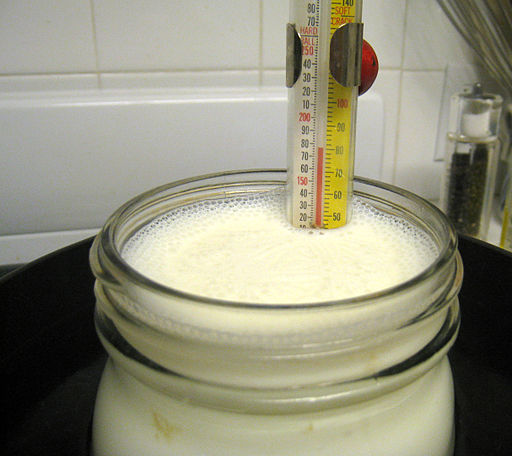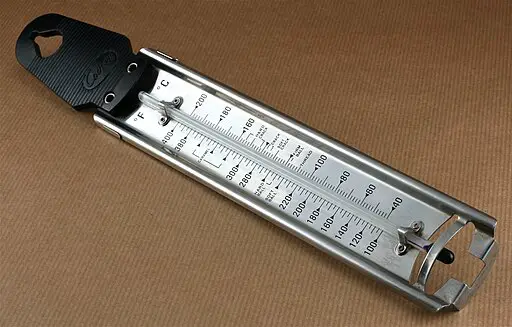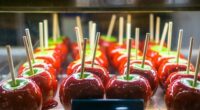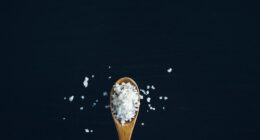A candy thermometer is designed specifically for monitoring sugar syrup temperatures when making candies, caramel sauces, or other sweet treats. A meat thermometer is used to measure the internal temperature of cooked meats.
TL;DR Candy thermometer Vs. Meat thermometer
A candy thermometer is designed for high-temperature cooking, specifically for making confections like caramel, while a meat thermometer is used to measure the internal temperature of cooked meats to ensure they are cooked to the desired level of doneness and safe to eat.
A candy thermometers usually have a wider temperature range and may come with a clip to attach to a pot, while meat thermometers have a pointed probe for insertion into meat and can be analog or digital.
What is a candy thermometer?

A candy thermometer, also known as a sugar thermometer, is a kitchen tool specifically designed to measure the temperature of syrups and other sweet concoctions.
It usually consists of a long metal probe with an attached clip that allows it to be securely attached to the side of a pot or pan. The primary function of a candy thermometer is to ensure precise temperature control during the candy-making process.
Candy thermometers typically have temperature readings ranging from around 100°F (37°C) up to 400°F (204°C). They are particularly useful for tasks such as making caramel, fudge, toffee, pralines.
What is a meat thermometer?

A meat thermometer is a handy tool used by cooks and chefs to ensure that their meat is cooked to the perfect temperature.
It consists of a long, pointed probe that is inserted into the thickest part of the meat. The thermometer then displays the internal temperature, giving you an accurate reading of how well-cooked your meat is.
There are different types of meat thermometers available on the market. Some have analog dials while others feature digital displays for easy reading.
Candy thermometer Vs. Meat thermometer – Key differences
| Characteristic | Candy Thermometer | Meat Thermometer |
|---|---|---|
| Intended Use | Specifically designed for making candy, caramel, and other confections at high temperatures | Designed for measuring the internal temperature of cooked meat and poultry |
| Temperature Range | Usually measures a wide range of temperatures, often from around 100°F to 400°F (40°C to 200°C) | Typically measures a more limited range, often from around 0°F to 220°F (-18°C to 104°C) |
| Accuracy | Precise and accurate for high-temperature cooking, where small temperature differences matter | Accurate for lower and medium temperature ranges, ideal for cooking meats to desired doneness |
| Construction | Made of stainless steel with a glass or plastic temperature scale | Often made of stainless steel with a pointed metal probe and a dial or digital display |
| Special Features | Comes with a clip to attach to the side of a pot or pan when cooking candy | Some meat thermometers have an alarm to indicate when the desired temperature is reached |
| Types | Can be analog (mercury-based) or digital | Can be analog (dial) or digital |
| Safety Concerns | Requires careful handling due to high-temperature use and hot sugar | Generally safe to use, but care should be taken with the pointed probe |
| Cleaning | Hand wash with care, avoid immersing the thermometer in cold water while hot | Hand wash or dishwasher safe, depending on the model |
| Versatility | Not suitable for measuring lower temperatures accurately | Suitable for a wide range of cooking tasks beyond meats, such as baked goods |
| Cost | Typically affordable | Moderately priced, depending on features and quality |
How to use a meat thermometer?
- Insertion: Insert the probe into the thickest part of the meat, away from bones and fat.
- Depth: Ensure the probe tip is in the center of the meat but not touching bone or the cooking surface.
- Wait: Allow the thermometer to stabilize and read the temperature, usually within a few seconds to a minute.
- Reading: Read the temperature displayed on the thermometer.
- Cleaning: Clean the meat thermometer thoroughly with warm soapy water after each use.
How to use a candy thermometer?
- Attachment: Clip the candy thermometer to the side of the pot or saucepan, ensuring it doesn’t touch the bottom.
- Submerging: Immerse the thermometer into the mixture, making sure the tip doesn’t touch the bottom of the pot.
- Reading Level: Check that the mercury or digital display is easy to read and aligns with the scale.
- Stirring: While cooking, stir the mixture gently and continuously for even temperature distribution.
- Avoiding Contact: Prevent the thermometer from touching the sides or bottom of the pot to get an accurate reading.
- Remove from Heat: Remove the thermometer from the mixture before removing the pot from the heat source.
- Reading Temperature: Read the temperature once the mercury stabilizes or the digital display stops changing.
- Careful Handling: Be cautious as the thermometer and mixture will be extremely hot; use oven mitts or heat-resistant gloves.
- Cleaning: Hand wash the candy thermometer with care, avoiding submerging it in cold water while hot, to avoid damage.
Image Credits
Featured Image By – Steven Jackson from USA, via Wikimedia Commons
Image 1 By – Dvortygirl, CC BY-SA 3.0 , via Wikimedia Commons
Image 2 By – cyclonebill from Copenhagen, Denmark, via Wikimedia Commons








